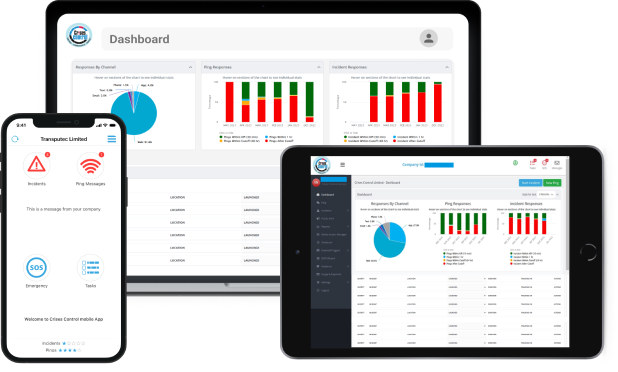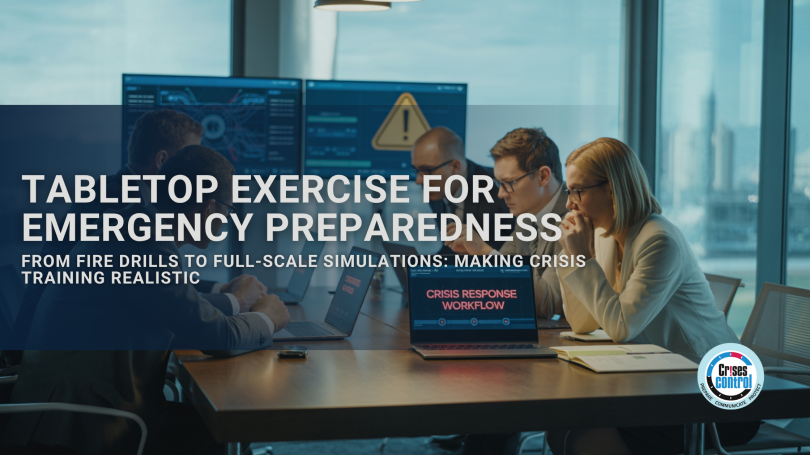Written by Asipe Nokenke | Marketing Assistant
Tabletop exercises expose the real test of your emergency plan, not when it’s written, but when it’s activated.
You’ve run the fire drills. The emergency exits are marked. A copy of the business continuity plan sits on the intranet. But when an actual incident unfolds, chaos takes over.
Someone triggers the alarm, but no one is quite sure what to do next. Teams scramble for instructions. Managers field questions they haven’t prepared for. And what starts as a routine test quickly reveals a lack of coordination, clarity, and control.
This is the moment when an emergency plan is truly tested. Not when it’s written, but when it’s activated. The reality is, most organisations aren’t failing because they lack a plan; they’re failing because they haven’t tested it under real-world conditions. This is where tabletop exercises come into play.
Beyond the Alarm Bell: Why Fire Drills Create a False Sense of Security
Fire drills have their place. They’re simple, repeatable, and required in most workplaces. But they only scratch the surface of emergency preparedness.
A fire drill checks that people can exit a building safely. It doesn’t tell you how leadership will communicate under pressure. It won’t show whether your customer-facing teams know what to say in a crisis. And it certainly won’t help IT simulate the fallout of a ransomware attack.
Real emergencies rarely follow a script. They involve uncertainty, overlapping responsibilities, and rapid decision-making. That’s exactly what tabletop exercises are designed to simulate.
What Makes a Tabletop Exercise Different?
Unlike basic drills, a tabletop exercise is a guided, scenario-based session where participants walk through their roles during a hypothetical crisis. The goal isn’t physical movement; it’s decision-making.
A well-run tabletop exercise brings together your key personnel to test:
-
- Communication paths, escalation procedures
-
- Role clarity
-
- Policy awareness
Rather than reenacting fire evacuations or testing alarms, you simulate a realistic threat like a data breach, supply chain disruption, or workplace incident, and walk through how your team would handle it from start to finish.
Common Mistakes in Running Tabletop Exercises
Tabletop exercises are only effective when they mirror the unpredictability of a real crisis. Unfortunately, many organisations fall into predictable traps:
-
- Too Theoretical
-
- Poor Facilitation
-
- No Defined Outcomes
-
- Lack of Follow-Up – The debrief is where the real value lives. Yet many organisations skip it. Without documenting gaps and assigning follow-up actions, the exercise becomes a one-off event.
Real-World Scenarios That Benefit from Tabletop Exercises
While you can theoretically run a tabletop for any type of disruption, these scenarios tend to generate the most insight:
-
- Cybersecurity Breach: How quickly can you isolate the incident? What’s your internal and external comms strategy?
-
- Natural Disaster: Who decides on business closures? Can remote work be initiated? How do you reach your people?
-
- Reputation Crisis: A viral social media backlash or product failure. What’s your holding statement? Who owns Media Response?
-
- Data Loss or Ransomware Attack: How does IT isolate affected systems? Who leads contact with regulators?
-
- Active Threat Situations: How are lockdowns triggered? Who speaks to emergency services?
In each case, the point isn’t to “win” the scenario. It’s to uncover weaknesses in your coordination and sharpen your response capability.
What Realistic Tabletop Exercises Look Like in Practice
Let’s say your leadership team is faced with a scenario: a major cyber incident just shut down internal systems. Emails aren’t going through, client data may be at risk, and media requests are already coming in.
In theory, everyone knows the steps from the emergency response plan. But in practice, questions pile up quickly.
-
- Who needs to be notified first?
-
- Which department leads the response?
-
- What should we tell customers?
-
- Where do we log our actions?
Without clear communication paths and structured coordination, even the best plans can stall. This is where some organisations rely on digital platforms that support multi-channel alerts, segmented messaging, and real-time oversight. Rather than sending ad hoc instructions through email or chat apps, they activate workflows that guide teams with role-specific tasks and timelines.
The result? Teams don’t waste time figuring out what to do or chasing updates. Actions are tracked, responsibilities are clear, and leadership has full visibility into how the situation is being handled.
When tabletop exercises incorporate these tools, they become much more than a box-ticking exercise; they simulate the true pressures of a crisis and test how well your organisation can respond when the pressure is real.
Building a Tabletop Exercise That Actually Works
If you’re running your first or your fiftieth tabletop exercise, here’s a proven structure that delivers results:
-
- Choose the Right Scenario
-
- Define Objectives
-
- Set Roles Clearly
-
- Simulate Real Conditions
-
- Debrief Honestly
How Tabletop Exercises Build a Resilient Culture
Perhaps the greatest value of tabletop exercises isn’t in the plan, it’s in the people.
By putting staff into realistic scenarios, you’re training their judgement, strengthening their confidence, and fostering a culture that values preparedness.
You’re also signalling something important: that crisis response isn’t someone else’s job. Everyone plays a role, and everyone’s input is valuable.
This shift from passive compliance to active participation is what turns emergency preparedness from policy into practice.
Conclusion: Test the Plan, Train the People, Strengthen the Response
You may already have a business continuity plan, an incident response manual, and a comms playbook. But none of these guarantees performance when pressure hits.
Tabletop exercises are the bridge between written policies and real-world decisions. They help uncover what’s missing, test your people’s readiness, and expose weaknesses in your communication flow before a real crisis does.
Organisations that run regular tabletop exercises don’t just comply with regulations, they build operational confidence. They train not just for what might happen, but for how to respond when it does.
Want to see what that looks like in your organisation?
Contact us today for a free personalised demo and see how your teams can train smarter, faster, and with more impact.
Request a FREE Demo

